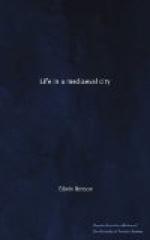In the fifteenth century the population of York, the greatest city of the north, was about 14,000. Newcastle was the next greatest, being one of the ten or twelve leading cities of mediaeval England which had a total population of about 2-1/2 millions. The inhabitants of York registered in 1911 numbered 83,802.
Within the city there was a number of sub-entities, each self-contained and definitely marked off, often by enclosing, embattled walls. Such was the Minster, which stood within its close. The Liberty of the Minster of St. Peter included the parts of the city immediately round the Minster, the Archbishop’s Palace, and the Bedern (a small district in the city where some of the Minster clergy lived collegiately), and groups of houses and odd dwellings scattered throughout other parts of the city and the county and elsewhere. Individual monasteries formed further such sub-entities; for instance St. Mary’s Abbey, which was actually outside the city walls, but within its own defensive walls; the Franciscan Friary near the Castle; Holy Trinity Priory; the royal Hospital of St. Leonard. The Castle, which obviously had to be enclosed and capable of maintaining and enduring isolation, was independent of the city. Each of these ecclesiastical institutions enjoyed a large measure of freedom from the rule of the municipal authorities. The city was also subdivided into parishes, which, of course, were not enclosed by walls. The parish boundaries, although less well defined than those of the areas above mentioned, were none the less distinctly marked.
B. STREETS
Streets, as we use the word to-day, were quite few in number. They were usually called gates and were mostly continuations of the great high-roads that came into and through the city, after crossing the wild country that covered most of northern England, a desert in which a city was an oasis and a sanctuary. In the lofty and graceful open lantern-tower of All Saints, Pavement, a lamp was hung to guide belated travellers to the safety and hospitality that obtained within the city walls. For the same purpose a bell was rung at St. Michael’s, Ouse Bridge.
There were a few buildings along the high-roads just outside the great entrances, the Bars. Besides the few hovels and huts there were hospitals for travellers. There were four hospitals for lepers, the most wretched of all the sufferers from mediaeval lack of cleanliness.
Most of the streets were mere alleys, passages between houses and groups of buildings. They were very narrow and often the sky could hardly be seen from them because of the overhanging upper storeys of the buildings along each side. Goods in the Middle Ages and right down to the nineteenth century were carried in towns by hand. Carriages and waggons and carts were not very numerous and would have no need to proceed beyond the main streets and the open squares. If men must journey off their own feet, they rode horses. Pack-horses were used regularly to carry goods, where nowadays a horse or, more probably, a steam or motor engine would easily pull the goods conveniently placed on a cart or lorry.




